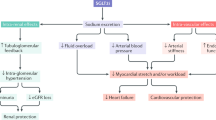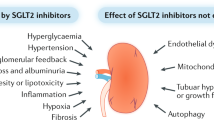Abstract
The naturally occurring substance phlorizin has long been recognized to block the reabsorption of glucose from the glomerular ultrafiltrate into the systemic circulation. The poor oral bioavailability and adverse effects associated with this agent, however, have prevented its use in clinical practice and restricted its use to that of a physiological tool. The development of novel agents that are able to block the principal glucose transporter in the kidney has allowed the inhibition of renal glucose reabsorption to be re-evaluated as a therapeutic tool in patients with diabetes mellitus. This Perspectives article summarizes current knowledge pertaining to glucose transport in the kidney and describes the evidence regarding glucose transport blockade as a novel target for the management of hyperglycemia in the context of existing treatment strategies.
This is a preview of subscription content, access via your institution
Access options
Subscribe to this journal
Receive 12 print issues and online access
$209.00 per year
only $17.42 per issue
Buy this article
- Purchase on Springer Link
- Instant access to full article PDF
Prices may be subject to local taxes which are calculated during checkout

Similar content being viewed by others
References
Wright, E. M., Hirayama, B. A. & Loo, D. F. Active sugar transport in health and disease. J. Intern. Med. 261, 32–43 (2007).
Bakris, G. L., Fonseca, V. A., Sharma, K. & Wright, E. M. Renal sodium-glucose transport: role in diabetes mellitus and potential clinical implications. Kidney Int. 75, 1272–1277 (2009).
Wright, E. M. Renal Na(+)-glucose cotransporters. Am. J. Physiol. Renal Physiol. 280, F10–F18 (2001).
Mogensen, C. E. Maximum tubular reabsorption capacity for glucose and renal hemodynamics during rapid hypertonic glucose infusion in normal and diabetic subjects. Scand. J. Clin. Lab. Invest. 28, 101–109 (1971).
Vestri, S. et al. Changes in sodium or glucose filtration rate modulate expression of glucose transporters in renal proximal tubular cells of rat. J. Membr. Biol. 182, 105–112 (2001).
Marks, J., Carvou, N. J., Debnam, E. S., Srai, S. K. & Unwin, R. J. Diabetes increases facilitative glucose uptake and GLUT2 expression at the rat proximal tubule brush border membrane. J. Physiol. 553, 137–145 (2003).
Rahmoune, H. et al. Glucose transporters in human renal proximal tubular cells isolated from the urine of patients with non-insulin-dependent diabetes. Diabetes 54, 3427–3434 (2005).
Freitas, H. S. et al. Na(+) -glucose transporter-2 messenger ribonucleic acid expression in kidney of diabetic rats correlates with glycemic levels: involvement of hepatocyte nuclear factor-1alpha expression and activity. Endocrinology 149, 717–724 (2008).
Ackermann, T. F. et al. SGK1-sensitive renal tubular glucose reabsorption in diabetes. Am. J. Physiol. Renal Physiol. 296, F859–F866 (2009).
Palmada, M. et al. SGK1 kinase upregulates GLUT1 activity and plasma membrane expression. Diabetes 55, 421–427 (2006).
Koro, C. E., Bowlin, S. J., Bourgeois, N. & Fedder, D. O. Glycemic control from 1988 to 2000 among US adults diagnosed with type 2 diabetes: a preliminary report. Diabetes Care 27, 17–20 (2004).
Singh, D. K., Winocour, P. & Farrington, K. Mechanisms of disease: the hypoxic tubular hypothesis of diabetic nephropathy. Nat. Clin. Pract. Nephrol. 4, 216–226 (2008).
Calado, J. et al. Familial renal glucosuria: SLC5A2 mutation analysis and evidence of salt-wasting. Kidney Int. 69, 852–855 (2006).
Jabbour, S. A. & Goldstein, B. J. Sodium glucose co-transporter 2 inhibitors: blocking renal tubular reabsorption of glucose to improve glycaemic control in patients with diabetes. Int. J. Clin. Pract. 62, 1279–1284 (2008).
Wilding, J. et al. A study of dapagliflozin in patients with type 2 diabetes receiving high doses of insulin plus insulin sensitizers: applicability of a novel insulin-independent treatment. Diabetes Care 32, 1656–1662 (2009).
[No authors listed] Intensive blood-glucose control with sulphonylureas or insulin compared with conventional treatment and risk of complications in patients with type 2 diabetes (UKPDS 33). UK Prospective Diabetes Study (UKPDS) Group. Lancet 352, 837–853 (1998).
Santer, R. et al. Molecular analysis of the SGLT2 gene in patients with renal glucosuria. J. Am. Soc. Nephrol. 14, 2873–2882 (2003).
Geerlings, S. E., Brouwer, E. C., Gaastra, W., Verhoef, J. & Hoepelman, A. I. Effect of glucose and pH on uropathogenic and non-uropathogenic Escherichia coli: studies with urine from diabetic and non-diabetic individuals. J. Med. Microbiol. 48, 535–539 (1999).
Geerlings, S. E. et al. Asymptomatic bacteriuria may be considered a complication in women with diabetes. Diabetes Mellitus Women Asymptomatic Bacteriuria Utrecht Study Group. Diabetes Care 23, 744–749 (2000).
List, J. F., Woo, V., Morales, E., Tang, W. & Fiedorek, F. T. Sodium-glucose cotransport inhibition with dapagliflozin in type 2 diabetes. Diabetes Care 32, 650–657 (2009).
Rossetti, L., Smith, D., Shulman, G. I., Papachristou, D. & DeFronzo, R. A. Correction of hyperglycemia with phlorizin normalizes tissue sensitivity to insulin in diabetic rats. J. Clin. Invest. 79, 1510–1515 (1987).
Blondel, O., Bailbe, D. & Portha, B. Insulin resistance in rats with non-insulin-dependent diabetes induced by neonatal (5 days) streptozotocin: evidence for reversal following phlorizin treatment. Metabolism 39, 787–793 (1990).
Kahn, B. B., Shulman, G. I., DeFronzo, R. A., Cushman, S. W. & Rossetti, L. Normalization of blood glucose in diabetic rats with phlorizin treatment reverses insulin-resistant glucose transport in adipose cells without restoring glucose transporter gene expression. J. Clin. Invest. 87, 561–570 (1991).
Pollock, C. A., Lawrence, J. R. & Field, M. J. Tubular sodium handling and tubuloglomerular feedback in experimental diabetes mellitus. Am. J. Physiol. 260, F946–F952 (1991).
Vallon, V., Richter, K., Blantz, R. C., Thomson, S. & Osswald, H. Glomerular hyperfiltration in experimental diabetes mellitus: potential role of tubular reabsorption. J. Am. Soc. Nephrol. 10, 2569–2576 (1999).
Malatiali, S., Francis, I. & Barac-Nieto, M. Phlorizin prevents glomerular hyperfiltration but not hypertrophy in diabetic rats. Exp. Diabetes Res. 2008, 305403 (2008).
Turk, E., Zabel, B., Mundlos, S., Dyer, J. & Wright, E. M. Glucose/galactose malabsorption caused by a defect in the Na+/glucose cotransporter. Nature 350, 354–356 (1991).
Wells, R. G. et al. Cloning of a human kidney cDNA with similarity to the sodium-glucose cotransporter. Am. J. Physiol. 263, F459–F465 (1992).
Zhou, L. et al. Human cardiomyocytes express high level of Na+/glucose cotransporter 1 (SGLT1). J. Cell Biochem. 90, 339–346 (2003).
Santer, R. & Calado, J. Familial renal glucosuria and SGLT2: from a mendelian trait to a therapeutic target. Clin. J. Am. Soc. Nephrol. 5, 133–141 (2010).
Scholl-Bürgi, S., Santer, R. & Ehrich, J. H. Long-term outcome of renal glucosuria type 0: the original patient and his natural history. Nephrol. Dial. Transplant. 19, 2394–2396 (2004).
Washburn, W. N. Development of the renal glucose reabsorption inhibitors: a new mechanism for the pharmacotherapy of diabetes mellitus type 2. J. Med. Chem. 52, 1785–1794 (2009).
Arakawa, K. et al. Improved diabetic syndrome in C57BL/KsJ-db/db mice by oral administration of the Na(+)-glucose cotransporter inhibitor T-1095. Br. J. Pharmacol. 132, 578–586 (2001).
Oku, A. et al. T-1095, an inhibitor of renal Na+-glucose cotransporters, may provide a novel approach to treating diabetes. Diabetes 48, 1794–1800 (1999).
Ueta, K. et al. Long-term treatment with the Na+-glucose cotransporter inhibitor T-1095 causes sustained improvement in hyperglycemia and prevents diabetic neuropathy in Goto-Kakizaki rats. Life Sci. 76, 2655–2668 (2005).
Marsenic, O. Glucose control by the kidney: an emerging target in diabetes. Am. J. Kidney Dis. 53, 875–883 (2009).
Katsuno, K. et al. Sergliflozin, a novel selective inhibitor of low-affinity sodium glucose cotransporter (SGLT2), validates the critical role of SGLT2 in renal glucose reabsorption and modulates plasma glucose level. J. Pharmacol. Exp. Ther. 320, 323–330 (2007).
Fujimori, Y. et al. Sergliflozin etabonate, a selective SGLT2 inhibitor, improves glycemic control in streptozotocin-induced diabetic rats and Zucker fatty rats. Eur. J. Pharmacol. 609, 148–154 (2009).
Fujimori, Y. et al. Remogliflozin etabonate, in a novel category of selective low-affinity sodium glucose cotransporter (SGLT2) inhibitors, exhibits antidiabetic efficacy in rodent models. J. Pharmacol. Exp. Ther. 327, 268–276 (2008).
Harrington, W. W. et al. Remogliflozin etabonate, a potent and selective sodium-dependent glucose transporter 2 antagonist, produced sustained metabolic effects in Zucker diabetic fatty rats. In 68th Scientific Sessions of the American Diabetes Association. San Francisco, California (2008).
Han, S. et al. Dapagliflozin, a selective SGLT2 inhibitor, improves glucose homeostasis in normal and diabetic rats. Diabetes 57, 1723–1729 (2008).
Meng, W. et al. Discovery of dapagliflozin: a potent, selective renal sodium-dependent glucose cotransporter 2 (SGLT2) inhibitor for the treatment of type 2 diabetes. J. Med. Chem. 51, 1145–1149 (2008).
Komoroski, B. et al. Dapagliflozin, a novel SGLT2 inhibitor, induces dose-dependent glucosuria in healthy subjects. Clin. Pharmacol. Ther. 85, 520–526 (2009).
Brooks, A. M. & Thacker, S. M. Dapagliflozin for the treatment of type 2 diabetes. Ann. Pharmacother. 43, 1286–1293 (2009).
Wancewicz, E. V. et al. Long term safety and efficacy of ISIS 388626, an optimized SGLT2 antisense inhibitor, in multiple diabetic and euglycemic species. In 68th Scientific Sessions of the American Diabetes Association. San Francisco, California (2008).
Author information
Authors and Affiliations
Corresponding author
Ethics declarations
Competing interests
C. Pollock has declared associations with the following companies: AstraZeneca and Boehringer Ingelheim. A. Mather has declared an association with Boehringer Ingelheim.
Rights and permissions
About this article
Cite this article
Mather, A., Pollock, C. Renal glucose transporters: novel targets for hyperglycemia management. Nat Rev Nephrol 6, 307–311 (2010). https://doi.org/10.1038/nrneph.2010.38
Published:
Issue Date:
DOI: https://doi.org/10.1038/nrneph.2010.38
This article is cited by
-
Mechanism of the blood pressure-lowering effect of sodium-glucose cotransporter 2 inhibitors in obese patients with type 2 diabetes
BMC Pharmacology and Toxicology (2017)
-
Ipragliflozin, a sodium–glucose cotransporter 2 inhibitor, ameliorates the development of liver fibrosis in diabetic Otsuka Long–Evans Tokushima fatty rats
Journal of Gastroenterology (2016)
-
Targeting of sodium–glucose cotransporters with phlorizin inhibits polycystic kidney disease progression in Han:SPRD rats
Kidney International (2013)
-
Safety, Tolerability, Pharmacokinetics, and Pharmacodynamics of Multiple Rising Doses of Empagliflozin in Patients with Type 2 Diabetes Mellitus
Diabetes Therapy (2013)



